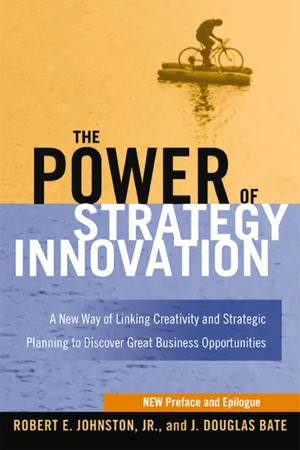CHAPTER 1
STRATEGY MEETS INNOVATION
If an organization is to meet the challenges of a changing world, it must be prepared to change everything about itself except its basic beliefs. The only sacred cow in an organization should be the basic philosophy of doing business.
—THOMAS J.WATSON
No corporate strategy lasts forever. Companies that get all the components of their business models working together can often drive their success for many years. But at some point, they start to run out of gas. Many companies are shocked to hear the financial engine sputter, having never paid much attention to their fuel gauge. Others have an eye on the gauge but don’t have a clue where the next service station is located, so they coast along, hoping to get lucky.
Then there are companies that have scouted out the road ahead and know their refueling options. With their eyes watching the road, the map, and the fuel gauge, they fill up the tank before it gets too low. Even older models, with the proper tune-up and constant refueling, can remain cruising at the speed limit for decades.
Your company needs strategy innovation initiatives to understand the road ahead and know your options for keeping the product tank full and the financial engine running smoothly.
What is strategy innovation?
Strategy innovation is shifting a corporation’s business strategy in order to create new value for both the customer and the corporation.
In a dynamic marketplace, every business runs the risk that its current business model will become obsolete. As long as there is customer value to be delivered, there will be companies interested in delivering it. New companies will create innovative, more efficient business models in order to compete in profitable industries. Consider the case of Wal-Mart. Starting as a discount retailer to the underserved population of rural areas, it needed to develop a new, more efficient retailing business model in order to survive in that segment of the retailing market. Using sophisticated technology and a streamlined distribution system, Sam Walton created a new business strategy in the retail industry that created value for both his rural customers and for his company. The superiority of their innovative business model ultimately led to Wal-Mart’s domination of that entire industry. The strongest survive.
In other dynamic industries of the twenty-first century, new technologies, new materials, and new distribution channels are continually changing the competitive landscape. Companies such as Nokia, Charles Schwab, and IBM recognized the potential of these changes, altered their business strategies, and have been able to take advantage of the emerging growth opportunities in wireless communications, financial services, and computer services. Companies such as K-Mart, USAirways, and Digital Equipment Corporation either did not see the trends in their industries or refused to alter their business strategies in times of change, and they have suffered the consequences. As Jack Welch, the highly successful former CEO of General Electric, once said about companies in dynamic markets, “When the rate of change outside exceeds the rate of change inside, the end is in sight.” 1
A Fight to the Photo-Finish
An example of the importance of strategy innovation in dynamic markets can be found in the photography industry. Back in the 1980s, Kodak and Polaroid were two prominent, global players in that industry. Kodak dominated the silver halide, 35-mm market while Polaroid, protected by its patents, owned the instant photography segment. At about that time, a new, disruptive technology was just beginning to emerge via the computer revolution, one that would threaten to make both conventional film processing technologies obsolete—digital imaging.
Kodak took the initiative in the late 1980s to understand the potential implications of this new technology. In two, large-scale strategy innovation initiatives, cross-functional teams of Kodak managers used panels of experts in this new technology to explore the emergence of digital photography and identify the potential new business opportunities of the future marketplace. From this work, Kodak understood the ramifications of digital photography on the industry and made important changes in their corporate strategy. R&D spending was immediately shifted from a focus on new silver halide projects to an interim, “hybrid” strategy, balancing the needs of the still-strong silver halide business with the growing potential of digital photography.
In the decade that followed, Kodak became a force in the world of digital photography, including the development of Picture CDs, Picture Maker kiosks, the purchase of their Japanese partner Chinon to manufacture digital cameras, the purchase of online photo-finisher Ofoto, and a joint venture with America Online called You’ve Got Pictures. As this book is being written, Kodak is transitioning with the market to digital photography, rather than being left in its wake. It shifted its business strategy to create new value for both Kodak and its customers.
Polaroid, on the other hand, ignored the early signs of digital photography and decided to stick with and protect their existing corporate strategy in instant photography. They did not understand how to create value in this emerging marketplace, preferring to compete using their old strategy, crafted in a very different era. On October 12, 2001, Polaroid filed for bankruptcy protection.
Companies that are attuned to the changes taking place in the market and see them as potential business opportunities are practicing strategy innovation. Companies that are eager to create new value for customers are practicing strategy innovation. Companies that are willing to redefine themselves and how they operate in order to pursue new, more vibrant growth initiatives are practicing strategy innovation.
Strategy Innovation Goes Beyond Product Innovation
It is interesting to note how many companies in recent years have adopted “innovation” as a core value or as part of their mission statements. If we as a society have moved from the Information Age to the Knowledge Age, then this relatively new emphasis on innovation is quite logical. When information is ubiquitous and is no longer a source of competitive advantage, it is the innovative use of that information (via knowledge) that differentiates people, companies, and nations. Innovation may become the basis of all competition in the future. Innovation is the new competitive arena where present-day gladiators, equipped with similar information and access to similar resources, try to outsmart one another to victory.
As we work with and read about corporations today, we see the focus of innovation being placed primarily on the products that they are creating. Go to a company’s Web site. If they talk about innovation or have an Office of Innovation, it is frequently related to the work done in their Research & Development labs. Innovation is usually thought of as invention. Innovation is usually new technology being turned into something unique and tangible that the company can sell. For those companies with strong R&D departments, this focus on the invention of innovative products is probably a key element of their corporate strategy.
There are, however, other elements of a corporate strategy beyond innovative products that can help companies compete in their markets. Besides having a product to sell, companies have to make that product and then get it into the hands of customers (and meet their customers’ needs). To do this, companies create specific functions such as manufacturing, sales, distribution, and marketing. These functions and how they interrelate make up the company’s business model. The effectiveness and efficiency of the business model is a critical element of a company’s strategy. Michael Porter, the corporate strategy guru at Harvard Business School, highlighted the importance of “fit” of the functional activities that make up a company’s strategy when he wrote, “Strategic fit among many activities is fundamental not only to competitive advantage but also to the sustainability of that advantage. . . . Positions built on systems of activities are far more sustainable than those built on individual activities.” 2
The implication here is that the most innovative product on the market may not be able to compete against a less advanced product that has a unique or superior business model. Dell Computer is a successful company because of its innovative business model (selling customized computers via the Internet and use of a very strong supply chain management), not because of its superior computers. Therefore, companies that do not have a world-class R&D capability may still be able to compete effectively in markets if they focus their efforts on building a superior business model.
Given the strategic importance of a company’s business model in its ability to compete in the marketplace, it is logical that efforts put into improving the business model could provide real value to a company. If that is true, then companies should place at least as much “innovation” focus on the other elements of the business model (and how they interact) as they currently do on the product side.
Strategy innovation is a process of applying innovative thinking to the entire business model of a company, not just to its products or inventions.
Strategy Innovation as a Strategic Advantage
Although strategy innovation may be critical for success (or survival) in dynamic markets, it can also be a source of competitive advantage in more stable markets. The company that understands how to create value for both their customers and thems...

